How To Learn Strumming On Acoustic Guitar

Strumming tin feel really awkward and unnatural at first.
But don't worry! With the right technique and some focused practice, strumming a guitar will get as easy and effortless equally riding a bike.
In this article, I'll show you how!

We'll offset off with some vital rhythm guitar tips that volition brand strumming a lot easier.
Next, I'll bear witness you a pace-by-step plan to learn a new strumming pattern, that helps you tap into your innate sense of rhythm. After all, StringKick is all virtually developing your musicality!
Nosotros'll and then explore vii popular strum patterns, from piece of cake to more than advanced, all with vocal examples, so you can hear what they sound like in 'existent music'.
Lastly, I'll tell you lot a scrap about Strumming Skills Bootcamp.
Alright, let's dive in!

1. Never cease moving your strumming hand
Keep your strumming hand moving at all times, fifty-fifty when you're non striking any strings for a couple of beats. By doing this, you don't have to think nearly when you demand to move your strumming paw: it'southward moving all the fourth dimension. Constantly moving your paw besides makes information technology much easier to go on time. Nosotros'll have a closer look at how this works later in this guide.

2. Keep a loose wrist
Make sure you're not locking your wrist: you need to keep it nice and loose.
Most of the motility volition come up from rotating your lower arm (you could as well say: twisting your wrist) and letting your hand and wrist hang loose and follow that motion. (Funk guitarist Ross Bolton calls this a 'drunken wrist'. I like that.)
You might be tempted to brand the up and down movement with your lower role of your arm (your forearm), merely though your lower arm volition be moving up and down a little chip besides, that's only a pocket-size part of the motility.

three. Go on a light grip on your (thin) pick
It's totally normal to desire to agree on to the choice tightly, because you lot don't want it to move and you don't desire to drop it. But by gripping it besides tight, y'all make it difficult for the pick to motility past the strings smoothly and it might get defenseless up in in that location somewhere. Also: information technology'due south actually difficult to proceed your wrist nice and loose when your gripping your pick tightly. By belongings your choice with a light grip, yous allow it to glide over the strings hands.
If you lot're not used to playing with a pick, it tin can really assistance to do with a thin choice that'southward nice and bendy. As you progress, try thicker picks too though, as they'll requite you a bit more control over your sound.

4. Don't hit all the strings with every strum
You might recollect nosotros need to hit all the notes in a chord with every strum, but very ofttimes we hit but three or iv strings.
So which strings should you be hitting? A skilful rule of thumb is to hit either all of the strings or just the lower (thicker) strings on every downstrum. And then on the upstrum, hit only the highest (thinnest) three or four strings. This approach volition brand the downstrums sound a bit heaver and give your upstrums a bit of a lighter sound. And: information technology'll be a little easier to play!
When you're strumming, you want to tap into that innate sense of rhythm likewise. That'south what volition make strumming feel easy and natural.
Experienced musicians do this automatically. It'southward why they'll say things like 'simply play what y'all feel' or 'I never recollect virtually strumming, I just do it'. Of class, once upon a time, strumming was hard for them likewise! It's only too long ago for them to remember.
Strumming is a lot like riding a bike in that way. It takes a bunch of practice at first, simply once things click, it feels like the easiest affair in the earth.
So, how exactly practise you go well-nigh using your natural sense of rhythm to strum a guitar? Let's take a look at how yous should acquire a strum pattern, pace by step!
Before nosotros get going, check out this quick video from my course Strumming Skills Bootcamp which has a quick caption of how rhythm works. (Naturally, the course is included in your membership if you're a StringKick All Access Fellow member!)
Next, allow'southward accept the simplest strum rhythm possible as an example.
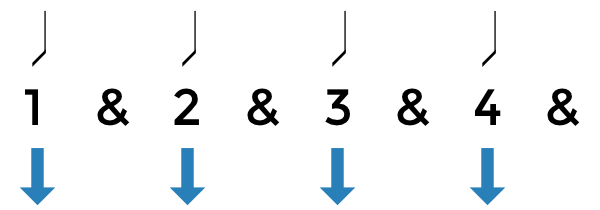
As you can come across, we need to strum on each trounce. So, how exactly would we become rhythm like this into our organization?
Hither's a iii step program!
How to Larn a New Strum Pattern

Footstep 1: Say it before you play information technology
Strumming patterns involve strumming down and strumming up. Now, while it's important to get this right, many players get a little caught upwardly in the mechanics of when your strumming hand needs to go upwards or down. It makes them lose the connection with their natural sense of rhythm.
It's impossible to play a rhythm without hearing what it should sound similar in your head. And so earlier y'all even touch your guitar and before we look at the downstrums and upstrums, we want to go the rhythm in our organization. Y'all want to be able to imagine in your mind what the strumming rhythm sounds similar. Yous want to hear it in your head.
A great style to check if yous actually 'know' the rhythm is to sing, hum, beatbox, tap or say it out loud. In other words: say information technology before you play information technology. 'Cause if you lot can't exercise that, playing a solid strumming groove on guitar volition be impossible.
For an instance of how to practise this with our rhythm, check out the video below, again from Strumming Skills Bootcamp.

Pace ii: Practice the strumming rhythm on just one chord
Once you accept the strumming rhythm in your mind, it's time to start playing it. Now, when you're learning something new, you want to focus on i matter at a fourth dimension. So, yous don't want to focus on playing your new strum pattern and have to think nigh irresolute chords.
Instead, you want to play the strum rhythm on but one chord. This allows yous to devote all your attending to the strumming. Below is a quick 'ane chord vocal' from Strumming Skills Bootcamp, completely played on a 1000 chord. So take hold of that chord and play along!

Step iii: Practice the strumming rhythm on a real song
One time you're comfortable playing the strum rhythm on one chord, it'south time to try information technology out in a existent vocal! The claiming here is to keep that strumming design going while you lot switch betwixt chords too.
This melody by Lee Hazlewood uses our 'strum on each beat out' strum pattern, while also switching between a few chords. Encounter if you can play along with information technology! When yous play the video, the right chords volition automatically calorie-free up, so you lot know where yous're supposed to exist.
(Sidenote: I've simplified the chords a little bit. Merely if you want the 'fancy' version which includes the Dmaj7 chord, flick the toggle to the acme correct of the chord progression!)
Hope you enjoyed this quick case! To learn more strumming patterns like this, check out Strumming Skills Bootcamp!
The course is totally included in your membership if y'all're a StringKick All Access Fellow member. If you're not a member, yous can check out the first couple of lessons of the course for free. Cheque it out!
Want to know a flake more about the course first? Find out more than hither.
Strum Pattern #ane Downstrum on every shell
When strumming a guitar, you'll utilise both downstrums (i.e. where your strumming hand moves downward) and upstrums (where your strumming hand moves back upwards). There's a simple logic backside when you should strum down or upward, which we'll get to shortly.
All the strum patterns we'll be looking at in this section are in a 4/4 measure out. In short, that ways that the music is divided into groups (called 'confined' or 'measures') that consist of four beats. (See the Rhythm Nuts video in section 2 for a more detailed explanation of this.)
For this first pattern, simply play a downstrum on every vanquish.
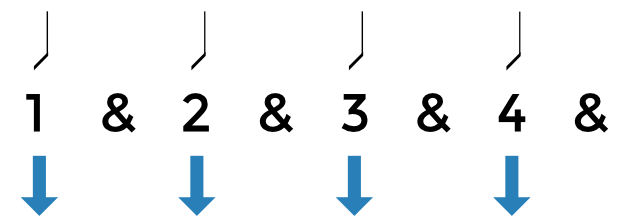
Check out the commencement thirty seconds of this vocal for an case of this simple, but constructive pattern:
Strum Blueprint #ii Adding two upstrums
Now that y'all've gotten a basic feel for this strumming thing, the next pace is to start adding some upstrums. Here'southward a pattern that's similar to the commencement pattern we saw, but with ii upstrums added in.

To hear this blueprint in action, check out this vocal. See if yous can recognize it.
(Note: If you want to play this vocal, listen closely! In the fourth bar, they've sneakily removed ii beats. So you'd count 1-two-iii-4, one-two-3-4, one-2-3-4, i-2, and then you lot repeat.)
Strum Pattern #3 Calculation iii upstrums
This adjacent pattern is similar to the terminal 1. We'll add together in but ane more upstrum.

Meet if you can hear it in this song.
Here's some other song case that's a bit faster:
Strum Pattern #4 Downstrum on the downbeat, Upstrum on the upbeat
You might accept noticed a sure logic in when we're playing downstrums and when we're playing upstrums: all the downstrums are on what we telephone call 'the downbeat': on the one, two, 3 or 4. All the upstrums are on what we call 'the and' or 'the upbeat': correct between the 1, two, three and 4. They're always on the '&'. This next design shows this basic logic:
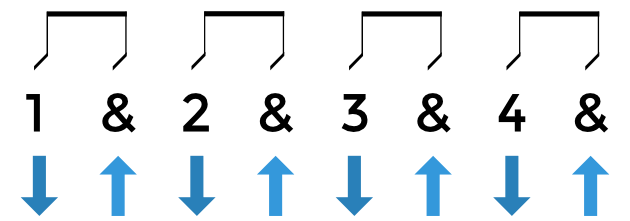
Equally you can see, we're strumming our instrument both on the downbeats and on the upbeats. This is a very common pattern. Listen to this song by Fleet Foxes for example.
Strum Design #5 Skipping a downstrum
Once you lot're comfy playing downwards and upstrums, there'due south just 1 more affair you need to acquire to consummate your basic strumming technique. So far, y'all might've noticed two things:
1. You lot're strumming paw keeps moving up and downward all the time. ii. Y'all're playing downstrums on the beat (1, 2, 3, 4) and upstrums on the upbeat (in other words: on the &).
I chose strumming patterns up until now where information technology feels sort of natural to exercise these two things. But there are also patterns where you might be tempted to interruption these 'rules'. Take a expect at this next strum pattern for example:
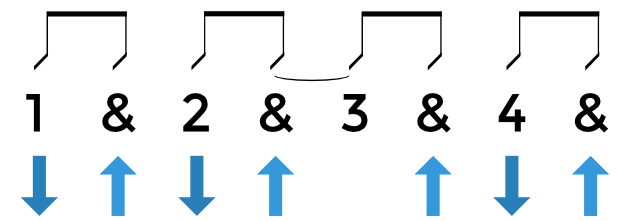
Run into how this blueprint skips the downstrum on the 3? As a result, it has two upstrums following each other, without a downstrum in between. This probably feels a little weird to play at beginning, but it'due south just a matter of getting used to it. Practice! Exist careful that y'all don't play a downstrum on the iii& instead of that upstrum. That would interrupt the downstrum-upstrum logic your hand is following.
Listen to this next song to hear what this rhythm sounds like.
Strum Pattern #half-dozen Skipping an upstrum and a downstrum
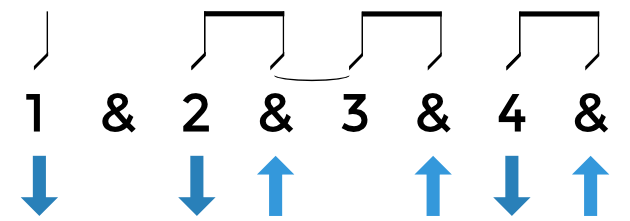
This next blueprint has the same claiming equally the last one: we're skipping a downstrum on the 3 (i.e. the third beat out). Because of that, nosotros accept to play two upstrums in a row which can feel bad-mannered at first.
This is a very common strum pattern though. But check out these song examples:
Strum Pattern #7 The one with the long interruption
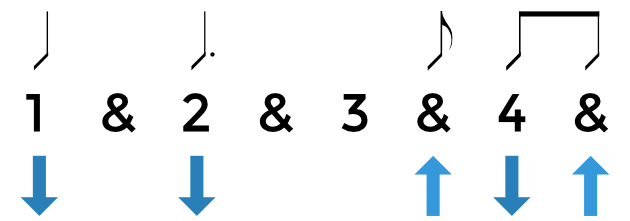
Now, for our terminal strum rhythm! The next design has you play fewer strums, which might seem easier, merely can be pretty tricky.
The claiming is to keep your strum hand moving during that long intermission between the 2 and 3&. It'south tempting to cease moving your paw, but you need to continue it moving at all times! Even when you're not striking any strings, your mitt needs to keep going upwards and down. This is essential to keeping a steady rhythm. Check out this vocal to hear the strum pattern in activeness:
Here's a slightly more rocky example:
And then, that was the last of our seven essential strum patterns! Promise yous enjoyed this little guided bout!
If yous desire to learn to play these strum patterns, check out Strumming Skills Bootcamp.
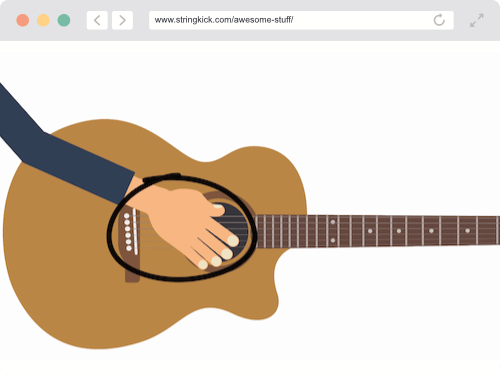
Strumming Skills Bootcamp volition teach you how to play all of these strum patterns and more! Y'all'll exercise them through 'one-chord-songs' fabricated specially for the grade too as dozens of songs past artists similar the Beatles, the White Stripes, Oasis and Arcade Burn.
Each of the songs comes with a chord progression that highlights what chord yous should play, making it super easy to follow along. 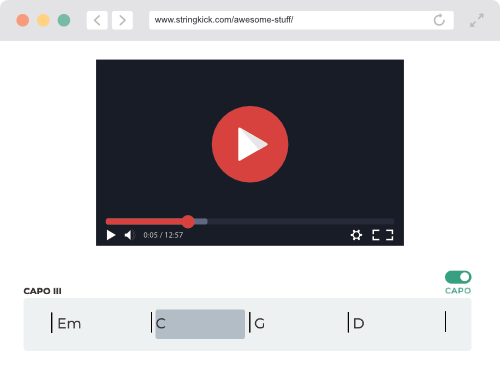
It's all laser-focused practice to get the right strumming technique into your organisation. By making strumming automatic, you lot won't have to think nigh how to movement your strumming hand anymore. It's what makes strumming feel effortless and natural.
Some more things you'll learn:
- How to utilize a capo
- Play with a straight or a swing feel
- Figure out how to play a strum pattern by ear
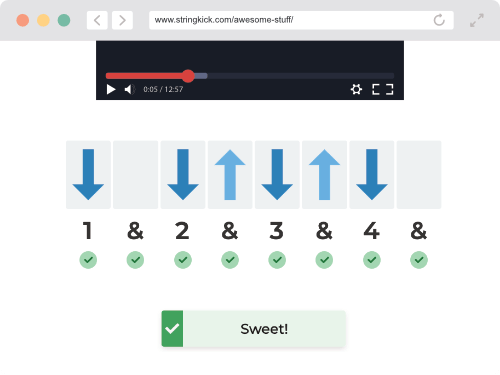
You can discover out more about the course here or merely become started with free sample course. This mini-course includes the first couple of lessons of the total course.
Decision
You lot know what they say. It ain't hateful a matter, if it ain't got that swing. Music always starts with a solid rhythm. You lot can even become away with playing 'wrong' notes or weird chords as they're properly timed. That's the power of rhythm.
I hope this article has helped you understand how to strum a guitar and has requite you some skilful exercise to get it in your organization. Proper strum technique helps you tap into your innate sense of rhythm! And as you may know, I'm all about helping you utilise and develop those inner music skills that make playing music feel natural. (Read more most that here!)
As always, if you lot have any questions, go in touch with me here or simply email me at Merely (at) Stringkick.com.
Source: https://www.stringkick.com/blog-lessons/strumming-patterns/
Posted by: jeffreycomman99.blogspot.com


0 Response to "How To Learn Strumming On Acoustic Guitar"
Post a Comment